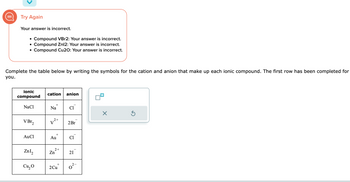Complete the table below by writing the symbols for the cation and anion that make up each ionic compound. The first row has been completed for you. ionic compound NaCl V Br₂ AuCl ZnI₂ Cu₂O cation anion + Na 0 Cl 0 0 0 0
Complete the table below by writing the symbols for the cation and anion that make up each ionic compound. The first row has been completed for you. ionic compound NaCl V Br₂ AuCl ZnI₂ Cu₂O cation anion + Na 0 Cl 0 0 0 0
Chemistry
10th Edition
ISBN:9781305957404
Author:Steven S. Zumdahl, Susan A. Zumdahl, Donald J. DeCoste
Publisher:Steven S. Zumdahl, Susan A. Zumdahl, Donald J. DeCoste
Chapter1: Chemical Foundations
Section: Chapter Questions
Problem 1RQ: Define and explain the differences between the following terms. a. law and theory b. theory and...
Related questions
Question

Transcribed Image Text:**Instructions:**
Complete the table below by writing the symbols for the cation and anion that make up each ionic compound. The first row has been completed for you.
**Table:**
| Ionic Compound | Cation | Anion |
|----------------|--------|-------|
| NaCl | Na⁺ | Cl⁻ |
| VBr₂ | | |
| AuCl | | |
| ZnI₂ | | |
| Cu₂O | | |
**Explanation of Graphs/Diagrams:**
- The table has three columns labeled "Ionic Compound," "Cation," and "Anion."
- The first row demonstrates NaCl broken down into its components: Na⁺ as the cation and Cl⁻ as the anion.
- There is an interactive element or tool depicted by an icon that allows users to fill in or clear fields. It indicates a selection or reset option, but the specific functionality is not detailed.
Expert Solution
This question has been solved!
Explore an expertly crafted, step-by-step solution for a thorough understanding of key concepts.
This is a popular solution!
Trending now
This is a popular solution!
Step by step
Solved in 2 steps with 1 images

Follow-up Questions
Read through expert solutions to related follow-up questions below.
Follow-up Question

Transcribed Image Text:# Ionic Compound Table Exercise
## Instructions
Try Again
**Your answer is incorrect.**
- Compound VBr₂: Your answer is incorrect.
- Compound ZnI₂: Your answer is incorrect.
- Compound Cu₂O: Your answer is incorrect.
Complete the table below by writing the symbols for the cation and anion that make up each ionic compound. The first row has been completed for you.
## Table
| Ionic Compound | Cation | Anion |
|----------------|--------|--------|
| NaCl | Na⁺ | Cl⁻ |
| VBr₂ | V²⁺ | 2Br⁻ |
| AuCl | Au⁺ | Cl⁻ |
| ZnI₂ | Zn²⁺ | 2I⁻ |
| Cu₂O | 2Cu⁺ | O²⁻ |
Use this table to practice understanding the composition of ionic compounds, identifying cations (positively charged ions) and anions (negatively charged ions).
Solution
Knowledge Booster
Learn more about
Need a deep-dive on the concept behind this application? Look no further. Learn more about this topic, chemistry and related others by exploring similar questions and additional content below.Recommended textbooks for you

Chemistry
Chemistry
ISBN:
9781305957404
Author:
Steven S. Zumdahl, Susan A. Zumdahl, Donald J. DeCoste
Publisher:
Cengage Learning

Chemistry
Chemistry
ISBN:
9781259911156
Author:
Raymond Chang Dr., Jason Overby Professor
Publisher:
McGraw-Hill Education

Principles of Instrumental Analysis
Chemistry
ISBN:
9781305577213
Author:
Douglas A. Skoog, F. James Holler, Stanley R. Crouch
Publisher:
Cengage Learning

Chemistry
Chemistry
ISBN:
9781305957404
Author:
Steven S. Zumdahl, Susan A. Zumdahl, Donald J. DeCoste
Publisher:
Cengage Learning

Chemistry
Chemistry
ISBN:
9781259911156
Author:
Raymond Chang Dr., Jason Overby Professor
Publisher:
McGraw-Hill Education

Principles of Instrumental Analysis
Chemistry
ISBN:
9781305577213
Author:
Douglas A. Skoog, F. James Holler, Stanley R. Crouch
Publisher:
Cengage Learning

Organic Chemistry
Chemistry
ISBN:
9780078021558
Author:
Janice Gorzynski Smith Dr.
Publisher:
McGraw-Hill Education

Chemistry: Principles and Reactions
Chemistry
ISBN:
9781305079373
Author:
William L. Masterton, Cecile N. Hurley
Publisher:
Cengage Learning

Elementary Principles of Chemical Processes, Bind…
Chemistry
ISBN:
9781118431221
Author:
Richard M. Felder, Ronald W. Rousseau, Lisa G. Bullard
Publisher:
WILEY